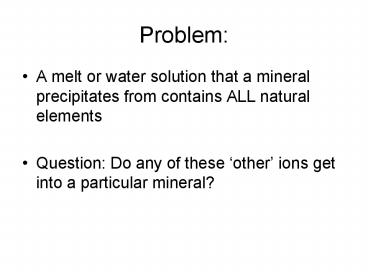Problem: - PowerPoint PPT Presentation
1 / 16
Title: Problem:
1
Problem
- A melt or water solution that a mineral
precipitates from contains ALL natural elements - Question Do any of these other ions get into a
particular mineral?
2
Chemical Formulas
- Subscripts represent relative numbers of elements
present - (Parentheses) separate complexes or substituted
elements - Fe(OH)3 Fe bonded to 3 separate OH groups
- (Mg, Fe)SiO4 Olivine group mineral composed
of 0-100 of Mg, 100-Mg Fe
3
Chemical heterogeneity
- Matrix containing ions a mineral forms in
contains many different ions/elements sometimes
they get into the mineral - Ease with which they do this
- Solid solution ions which substitute easily form
a series of minerals with varying compositions
(olivine series ? how easily Mg (forsterite) and
Fe (fayalite) swap) - Impurity defect ions of lower quantity or that
have a harder time swapping get into the structure
4
Chemical fingerprints of minerals
- Major, minor, and trace constituents in a mineral
- Stable isotopic signatures
- Radioactive isotope signatures
5
Stable Isotopes
- A number of elements have more than one naturally
occuring stable isotope. - Why atomic mass numbers are not whole ? they
represent the relative fractions of naturally
occurring stable isotopes - Any reaction involving one of these isotopes can
have a fractionation where one isotope is
favored over another - Studying this fractionation yields information
about the interaction of water and a
mineral/rock, the origin of O in minerals, rates
of weathering, climate history, and details of
magma evolution, among other processes
6
Radioactive Isotopes
- Many elements also have 1 radioactive isotopes
- A radioactive isotope is inherently unstable and
through radiactive decay, turns into other
isotopes (a string of these reactions is a decay
chain) - The rates of each decay are variable some are
extremely slow - If a system is closed (no elements escape) then
the proportion of parent (original) and daughter
(product of a radioactive decay reaction) can
yield a date. - Radioactive isotopes are also used to study
petrogenesis, weathering rates, water/rock
interaction, among other processes
7
Major, minor, and trace constituents in a mineral
- A handsample-size rock or mineral has around
51024 atoms in it theoretically almost every
known element is somewhere in that rock, most in
concentrations too small to measure - Specific chemical composition of any mineral is a
record of the melt or solution it precipitated
from. Exact chemical composition of any mineral
is a fingerprint, or a genetic record, much like
your own DNA - This composition may be further affected by other
processes - Can indicate provenance (origin), and from
looking at changes in chemistry across
adjacant/similar units - rate of precipitation/
crystallization, melt history, fluid history
8
Stoichiometry
- Some minerals contain varying amounts of 2
elements which substitute for each other - Solid solution elements substitute in the
mineral structure on a sliding scale, defined in
terms of the end members species which contain
100 of one of the elements
9
- KMg3(AlSi3O10)(OH)2 - phlogopite
- K(Li,Al)2-3(AlSi3O10)(OH)2 lepidolite
- KAl2(AlSi3O10)(OH)2 muscovite
- Amphiboles
- Ca2Mg5Si8O22(OH)2 tremolite
- Ca2(Mg,Fe)5Si8O22(OH)2 actinolite
- (K,Na)0-1(Ca,Na,Fe,Mg)2(Mg,Fe,Al)5(Si,Al)8O22(OH)2
- Hornblende
Actinolite series minerals
10
Compositional diagrams
Fe3O4 magnetite
Fe2O3 hematite
FeO wustite
A
Fe
O
A1B1C1
x
A1B2C3
x
C
B
11
Pyroxene solid solution ? MgSiO3 FeSiO3
Olivine solid solution ? Mg2SiO4 Fe2SiO4
12
Minor, trace elements
- Because a lot of different ions get into any
minerals structure as minor or trace impurities,
strictly speaking, a formula could look like - Ca0.004Mg1.859Fe0.158Mn0.003Al0.006Zn0.002Cu0.001P
b0.00001Si0.0985Se0.002O4 - One of the ions is a determined integer, the
other numbers are all reported relative to that
one.
13
Normalization
- Analyses of a mineral or rock can be reported in
different ways - Element weight - Analysis yields x grams element
in 100 grams sample - Oxide weight because most analyses of minerals
and rocks do not include oxygen, and because
oxygen is usually the dominant anion - assume
that charge imbalance from all known cations is
balanced by some of oxygen - Number of atoms need to establish in order to
get to a minerals chemical formula - Technique of relating all ions to one (often
Oxygen) is called normalization
14
Normalization
- Be able to convert between element weight ,
oxide weight , and of atoms - What do you need to know in order convert these?
- Elements weight ? atomic mass (Si28.09 g/mol
O15.99 g/mol SiO260.08 g/mol) - Original analysis
- Convention for relative oxides (SiO2, Al2O3,
Fe2O3 etc) ? based on charge neutrality of
complex with oxygen (using dominant redox species)
15
Normalization example
- Start with data from quantitative analysis
weight percent of oxide in the mineral - Convert this to moles of oxide per 100 g of
sample by dividing oxide weight percent by the
oxides molecular weight - Fudge factor from Perkins Box 1.5, pg 22 is
process called normalization where we divide
the number of moles of one thing by the total
moles ? all species/oxides then are presented
relative to one another
16
(No Transcript)































